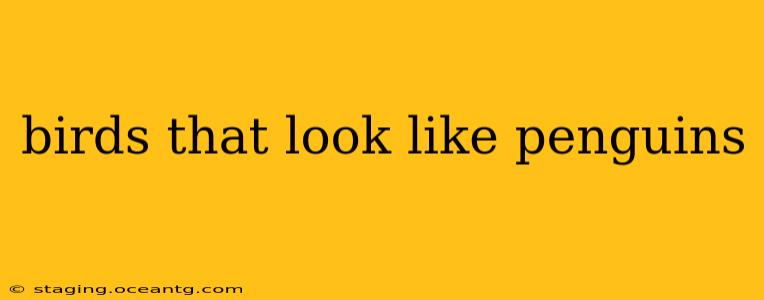Penguins are instantly recognizable with their sleek, black and white plumage, upright posture, and waddle. But surprisingly, several other bird species share some striking similarities, leading many to wonder, "What other birds look like penguins?" This often stems from convergent evolution, where unrelated species develop similar traits due to adapting to similar environments. While no bird perfectly replicates a penguin, several species exhibit fascinating resemblances. Let's dive into the avian world and explore some of these intriguing look-alikes.
What birds are similar to penguins?
This question is multifaceted, depending on what aspects of the penguin's appearance you're focusing on. Are you looking at overall shape and posture, color patterns, or specific behavioral characteristics? Several species exhibit similarities in one or more of these areas. Some of the closest resemblances come from birds in completely different families, highlighting the power of natural selection.
What other flightless birds look like penguins?
Flightlessness is a key feature of penguins, and while no other bird perfectly mirrors their build, certain flightless birds share a similar body shape and posture. The most notable examples include:
-
Great Auk: Though sadly extinct, the Great Auk was a large, flightless bird with a black and white plumage pattern reminiscent of penguins. They shared a similar upright posture and body shape. While the exact degree of resemblance is debated among ornithologists, their overall appearance evoked a clear comparison.
-
Certain species of Auks: While not entirely flightless, some auk species, particularly those that spend significant time in the water like puffins, share similarities in body shape and coloration with penguins. Their stout bodies, short wings, and black and white markings create a visual resemblance, especially when observed from a distance.
Do any flying birds look like penguins?
While flightlessness is a defining penguin characteristic, some flying birds share specific features that evoke a penguin-like appearance. These similarities are usually more subtle:
-
Guillemots: These diving birds have a streamlined body shape similar to penguins, and certain species exhibit a predominantly black and white plumage. Their swimming style, although different in detail, also shares a similar elegance and efficiency.
-
Razorbills: Similar to guillemots, razorbills share a black and white coloration and a streamlined body ideal for diving and swimming. Their behavior, focusing on coastal areas and diving for fish, also creates a loose resemblance to penguin behavior.
What are some birds that mimic penguin behavior?
Beyond physical appearance, some birds exhibit behavior patterns that echo those of penguins. These behavioral similarities, even without striking visual resemblance, contribute to the association:
- Diving birds: Many species of diving birds, such as cormorants and gannets, share the characteristic diving behavior of penguins. While their body shapes might differ considerably, their hunting techniques often bear a resemblance, showcasing similar adaptations to an aquatic lifestyle.
Are there any small birds that look like penguins?
It's important to note that there aren't small birds that exhibit a strong overall resemblance to penguins. The size and shape of penguins are quite unique. While some small birds may share elements of coloration or behavior, the overall penguin silhouette is largely unmatched in smaller species.
Why do some birds resemble penguins?
The similarities between penguins and other bird species arise from convergent evolution. This means that unrelated species, facing similar environmental pressures (in this case, a marine or coastal environment requiring efficient swimming and diving), evolve similar physical characteristics and behaviors independently. This fascinating process underscores the power of natural selection in shaping avian diversity.
This exploration of birds that look like penguins highlights the remarkable adaptations of various avian species and the intriguing ways unrelated creatures can converge upon similar solutions to ecological challenges. While no bird is a perfect replica, the subtle and sometimes striking similarities offer a captivating glimpse into the wonders of evolutionary biology.
